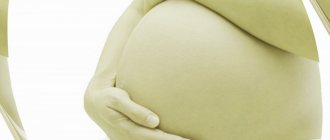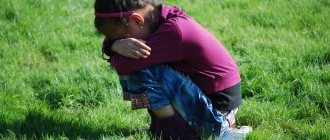How many baby teeth should a child have at 2 years old, and how does the teething process occur?
After the baby's first teeth appear, parents look forward to the moment when the child has a full set of teeth.
Often inexperienced young mothers are interested in how many teeth a 2-year-old toddler can have within the normal range, since the next child has twelve of them, but her own child has only eight. The child is not to blame for anything, and this in no way indicates that he is behind his peers in development. Milk teeth come in differently for everyone. Some began to climb at four months, and by the age of two there were only 10, while for others they began to cut only at 11 months, and by 2 years there were already 18 units. No one can influence this process in any way, so mothers should find out how many teeth a two-year-old child can normally have, be patient and wait until all the teeth erupt.
How many baby teeth should a child have at 2 years old?
Teething is a long and very difficult period for both the children themselves and their parents.
It is accompanied by periodic moodiness and poor health. But most importantly, the result is a complete set of baby teeth, which is formed by the end of the second year of life.
By this important period, every parent should know how many baby teeth children should have at the age of 2, how to care for them and when to go to the pediatric dentist.
The process of formation of the primary dentition in accordance with average statistical data can be traced in the table:
AgeWhich teeth erupt
| 6 months | Incisors (lower central) |
| 8 months | Incisors (upper central) |
| 10 months | Incisors (upper lateral) |
| 1 year | Incisors (lower lateral) |
| 14–16 months | Molars – fourth teeth (lower and upper) |
| 16–18 months | Upper canines |
| 18–20 months | Lower canines |
| 20–24 months | Molars – fifth teeth (lower and upper) |
In some tables you can find later dates for teething - up to 33 months of life. Each person’s body develops according to an individual plan, so the time of appearance of certain teeth may differ in different children. Taking into account individual characteristics, a 2-year-old child may have from 16 to 20 teeth .
The number of teeth that a child should have at a given age can be calculated using the formula. To do this, you need to subtract 4 from the number of months lived. Returning to the table, you can check the calculations: 6 months minus 4 equals two (2 lower incisors), 12 months minus 4 equals 8 (paired lower and upper central and lateral incisors).
Pathologies during teething
Some children do not have the normal number of teeth at 2 years of age, or they erupt in the wrong position.
Another alarming symptom in which it is imperative to show the baby to the pediatric dentist is the eruption of only one tooth out of a pair, when the next teeth according to the plan have already appeared.
For example, if there is only one canine, and all the molars have already erupted, you should go to the doctor for an examination. The reasons for such deviations may be:
- Bad habits, poor nutrition of the mother during pregnancy. Such factors influence the process of formation of tooth buds. If, due to starvation, vitamin deficiency, or the effects of toxic substances, tooth germs are not formed in the fetus, the child will subsequently not cut out the corresponding teeth.
- Poor nutrition of the mother during lactation and untimely or incorrect introduction of complementary foods to the infant. The development of teeth may be disrupted, and defects in individual dental tissues are possible.
- Improper formation of bone and dental tissue in rickets due to vitamin D deficiency.
- Congenital anomalies causing malocclusion.
- Excessive fluoride content in drinking water, which leads to the development of fluorosis - the appearance of stains on the enamel.
- Frequent and chronic diseases, endocrine disorders interfere with the normal development of the dentofacial apparatus.
Taking care of dental health
By age 2, a child should have 16–20 teeth. But no matter how many there are, parents should be attentive to their health. Regular examinations of the baby’s oral cavity will help identify dental diseases at an early stage of development; if any violations are detected, you should contact the dentist. To prevent dental problems, moms and dads should:
- Properly organize the baby’s nutrition, try to prolong natural feeding: if the mother has breast milk, you need to feed the baby for at least six months . During regular visits to the pediatrician, parents receive recommendations from the doctor on the introduction of complementary foods (vegetable purees, juices, meat soups).
- Wean your child off pacifiers and bottles with nipples in a timely manner, as they damage teeth and can cause bottle caries.
- Give your baby not only soft foods and mashed purees, but also solid foods. At two years old, a child has enough teeth to chew vegetables and fruits. This helps strengthen the developing teeth.
- Control the amount of sweets your child consumes.
- Brush your baby's teeth with a soft-bristled brush without toothpaste or with a special children's toothpaste with a minimum content of harmful impurities. There are also devices for cleaning teeth that are made of soft silicone - they are put on the finger and clean the baby’s oral cavity.
- Periodically show the child to a pediatric dentist to monitor the condition of the teeth.
- Monitor the quality of water your baby drinks. fluorine and other impurities in water should not exceed the norm.
Why is tooth decay dangerous for children?
At 2 years old, teeth should not only be in the required quantity, but also in normal condition. Despite the fact that information about the need to take care of the oral cavity is available to almost all modern parents, many of them do not take this problem seriously enough.
Some mothers and fathers are in no hurry to take their 2-year-old child to the dentist even after detecting signs of tooth decay.
There is a common misconception that once baby teeth fall out, their condition does not matter, because in the future the child will have a permanent set of teeth.
But in fact, caries and other dental damage should always be treated, regardless of age. There are several reasons for this:
- With any unevenness in the enamel, and even more so in the presence of a carious cavity, it becomes more difficult to brush your teeth. As a result, part of the plaque is not removed, and the place where it remains becomes a focus for the development of infection. Stomatitis and ENT diseases may become more frequent. Microbes that accumulate on teeth can even infect a child’s internal organs.
- Progressive damage to the tooth can affect its internal part, the pulp. Pulpitis causes severe pain, which causes a 2-year-old child a lot of suffering.
Half-destroyed milk teeth with foci of purulent inflammation can adversely affect the formation of permanent dentition, and the development of the rudiments of new teeth may be disrupted.
If your child has dental diseases, he or she may need a filling or surgical treatment - tooth extraction, which should be carried out only if it cannot be saved.
Caring for your baby’s teeth should begin not when the first teeth appear, but during pregnancy. At two years old, your baby should be taught hygiene habits so that he can properly care for his oral cavity throughout his life.
Normally, a child should have 20 teeth by the age of two. If their number noticeably lags behind the norm, or other suspicious symptoms are noticed - damage to the enamel or malocclusion - you need to consult a doctor. Periodic dental examinations will help diagnose dental problems in a timely manner and maintain the health of your permanent dentition.
Source: https://StomaGet.ru/detskaya-stomatologiya/skolko-zubov-dolzhno-byt-v-2-goda
Timing of baby teeth eruption
Even in the mother's womb, at 6-7 weeks of pregnancy, the rudiments of the child's future teeth are formed.
By the fifth month, the rudiments of permanent teeth are formed. In very rare cases, children are born with one or more teeth. It is impossible to talk about the exact timing of teething, since everyone’s teeth grow differently. Average indicators indicate that the first tooth emerges between four and six months, and by the age of one year the baby should normally have eight incisors, four on top and four on bottom. From the age of one year to 1.5 years, the child has four more teeth - the first molars (one on each side), and the total number of snow-white pearls in the baby’s mouth is twelve units.
By the age of two, fangs should erupt, and the number of teeth increases by another four teeth, that is, sixteen pieces. The last four teeth will finally erupt closer to 2.5-3 years. It is at this age that children have a full set of baby teeth.
These are just average indicators that doctors and parents rely on, so the data presented here cannot be considered a strict norm. Any minor deviations are possible and should not cause panic or concern for parents, since sooner or later all teeth will erupt.
Timing of teething in babies
Babies' first milk teeth appear at the age of 6-7 months. The lower incisors erupt first, followed by the upper incisors after 3-6 weeks. The upper and lower lateral incisors grow between the ages of 9 and 12-13 months. The growth of fangs occurs closer to 1.6-2 years. Molars are the last to be born. The teething process is completed by the age of 3 years.
Approximate order of teething:
| Lower central incisors (1) | 6-7 months |
| Upper central incisors (2) | 8-9 months |
| Upper lateral incisors (3) | 9-11 months |
| Lower lateral incisors (4) | 11-13 months |
| Upper small molars (molars) (5) | 12-15 months |
| Lower small molars (molars) (6) | 12-15 months |
| Upper canines (7) | 16-18 months |
| Lower canines (8) | 18-20 months |
| Lower large molars (molars) (9) | 24-30 months |
| Upper large molars (molars) (10) | 24-30 months |
Often, teeth appear according to individual timing. Parents don't need to worry. A deviation from the norm of 1-2 months is not a pathology. If the schedule changes significantly, the help of a doctor is necessary. The examination begins with a pediatrician and dentist.
Causes of early or late appearance of teeth in infants:
- genetic predisposition. If the baby is already 8 months old and there are no signs of teething, talk with relatives. Perhaps the late appearance of teeth is a variant of the family norm;
- lack of vitamins;
- metabolic disease;
- pathology of the thyroid gland;
- rickets.
Sometimes babies are born with teeth already erupted. Incisors that grow before birth are called natal, and those that appear between 1 and 3 months of life are called neonatal.
Prematurely erupted teeth cause inconvenience to babies and their mothers. When feeding, the baby systematically injures the mucous membrane of the frenulum of his own tongue, bites and injures the mother's breast. Congenital teeth have increased mobility. As a result, there is a risk of premature loss of the incisor and aspiration of the baby by a foreign body.
Incisors are complex (primary milk) and spare (additional). If the primary primary incisors are removed prematurely, the formation of the jaw bones will be disrupted in the future and occlusion pathology will occur. Therefore, it is recommended to preserve complex teeth.
Additional incisors are flexible and fall out on their own for the first 2-6 weeks of a baby’s life. More often, with the consent of the parents, spare teeth are removed, as they cause inconvenience and interfere with the growth of full-fledged milk teeth.
What to do with natal and neonatal teeth is decided jointly by the pediatrician and the dentist.
What determines the speed of teething?
The rate of teeth eruption and growth in a child depends on many factors. First of all, it is a hereditary predisposition, especially on the maternal side. If a mother had a full set of teeth late, she should not expect her child to have all the teeth appear earlier. The time of eruption of the first tooth is also important. If it erupts later than expected, other teeth will also appear with some delay. Although there are also known opposite cases, when after the first tooth erupts late, the rest come out very quickly.
How children's teeth grow at 2 years old also depends on the general condition of their body. If there is a deficiency of vitamins, micro- and macroelements in a child’s food, his teeth will lag in growth. In addition, if your baby is often sick or has a weakened immune system, you should not expect rapid teeth growth.
However, you need to remember that if the number of teeth in a child is significantly behind the norm, he needs to be shown to a specialist. Even if the doctor does not determine any deviation from the norm, the mother will have no reason to worry about the baby’s health.
Permissible deviations in terms
The timing of teething is influenced by numerous factors, so it is impossible to judge how many teeth a 2-year-old child should have. It is believed that normally there should be 16 fully formed teeth at two years of age, but there may be more or less of them depending on the characteristics of the child’s body, its heredity, health status, lifestyle and many other nuances.
It is necessary to understand in more detail which deviations from the established norm are permissible, and which indicate the presence of pathology. You need to understand that every rule has its exceptions.
If by the age of two the child does not have the notorious 16 teeth, this may indicate that the first teeth came in quite late, or that a hereditary factor played a role. The number of teeth can range from 12 to 20 units. If by this time the baby has significantly fewer or more teeth, this is a reason to seek advice from a pediatric dentist. Only he can refute or confirm the presence of pathology of dental development.
Uncharacteristic symptoms
The appearance of baby teeth in children usually begins at 6 months. If you carefully observe your child’s behavior, you can notice symptoms of teething two weeks before.
Symptoms can be divided into two types:
- the first type - includes general characteristics;
- the second is local signs of eruption.
General: the child picks up food, lack of appetite for no reason, bad mood, irritability, lack of sleep or restless sleep. Children who are breastfed from the first days of life more often require breastfeeding.
When teething, many parents notice that their baby tries to put everything in his mouth. This is how the baby strives to reduce the discomfort or pain that teething causes.
Massages and scratches the gums in this way. Long before teeth begin to appear, the child begins to salivate.
Gradually, the flow of saliva increases several times. But to say that this is a 100% symptom of teething is not entirely true.
This fact only indicates that the baby’s salivary glands have begun to work actively.
If a woman is breastfeeding her baby, then most often during night feedings she may feel a slight biting of the nipple. Often mothers and fathers notice that before teething begins, the baby develops an asymptomatic runny nose.
You should know that a runny nose can be caused by the appearance of the upper teeth in front. And also fangs.
In other cases, a runny nose may be caused by a viral infection. A runny nose does not create any particular difficulties for the child; the liquid from the nose has a transparent color (almost like water).
If a yellowish or greenish tint appears, there is reason to worry. If you have a persistent runny nose, you may need to consult your local pediatrician to find out the real reasons.
The second type of signs is local in nature. Using them, you can more accurately calculate the beginning of the appearance of teeth. If there are signs of the first group, it is necessary to examine the oral cavity and gums. If you carefully examine your gums, you will notice reddened and swollen areas. This indicates the imminent appearance of the first teeth. As a rule, the lower incisors erupt first.
If such symptoms are detected, one can confidently expect the eruption of the first teeth. After a little time has passed, you may notice a tooth appearing through the gum. Every day the tooth will grow and you will be able to feel it with your finger. Your first tooth. How long have you and your baby been waiting for him, how many difficulties have you gone through?
Sometimes parents try to attribute symptoms to a condition rather than find the actual cause. This happens with teething in children. If the symptoms are somewhat more pronounced, do not immediately attribute it to the teeth.
Here are the symptoms you shouldn't have:
- body temperature above 38.5 degrees;
- repeated vomiting and diarrhea for several days;
- severe and prolonged cough;
- runny nose with yellow or green snot;
- any bleeding.
If pronounced symptoms appear in both infants and older children, you should consult a pediatrician and rule out serious causes and diseases with similar symptoms.
It is very important to monitor the symptoms of teething at any age and distinguish them from signs of diseases not related to teeth.
Teething order
The process of teething takes about two and a half years, starting at 4-6 months and ending at 2.5-3 years. From the moment when the mother first noticed the characteristic signs of the approaching long-awaited event, and until the last tooth erupts, you need to carefully monitor this process, since the order of teething also plays an important role.
Normally, the incisors erupt first and, as a rule, the lower ones first, but small deviations are allowed here, that is, the upper ones can come in first, or alternate with the lower ones. Any option is normal.
Following the incisors are the first molars, followed by the canines, after which the second molars begin to cut. There should be a total of twenty baby teeth.
To make sure that the child’s teeth appear according to the established norm, dentists even invented a special formula for calculating the number of teeth for children at different ages. The essence of this formula is that it is necessary to subtract the number 4 from the age in months, that is, 12-4 = 8, respectively, in 2 years - 24-4 = 20. That is, at the age of two years all baby teeth can be present, and this is the norm. The sequence of eruption and the order in which teeth appear is shown below.
Table. Teething order:
Teething order
Your baby should have his first teeth by 6 months. It often happens that teeth begin to grow earlier or later than this period by two to three months. This is considered the norm.
The teeth appear in a certain sequence: first the two lower ones, followed by the two upper central incisors. By the age of one year, two more upper and lateral incisors grow. By his first birthday, your baby should have eight teeth.
The next stage of teething occurs between one and two years of age. During this period, molars begin to appear. Molars are teeth with which a person initially processes food; they are located next to the incisors. By two years, four upper and lower molars, as well as canines, should grow.
Thus, by the age of two, a baby can have from 16 to 20 baby teeth. But everything is purely individual; for one reason or another, the baby’s teeth may appear earlier or later than this period.
Pathologies of tooth growth in two-year-old children
The teething of a child according to a schedule, that is, according to a scheme compiled from average statistical indicators, is evidence of the normal development of the child and the process of teething itself (for more details, see the article: scheme and timing of teething in a child). Minor deviations in one direction or another are acceptable, which is considered within normal limits. Atypical situations also occur, although they are rare. They may indicate the presence of pathology and impaired development of the baby. Only a doctor can determine whether there is a pathology or not.
A shift in the timing of eruption by several months usually indicates a serious disease - rickets, which develops against the background of an acute deficiency of vitamin D, due to which the body practically does not absorb calcium, which is necessary for the healthy growth of bones and teeth, in particular.
A tooth can also erupt outside the arch of the dentition, which is an abnormal phenomenon and requires the intervention of a specialist. One of the serious pathologies is the incorrect formation of a single unit or several at once. They are of irregular shape, color, and occupy an unusual position in the mouth. Typically, such defective units must be removed, but the decision to correct the problem rests with the dentist.
Dental diseases in a child aged 2 years
Parents should carefully monitor the number of teeth, their frequency of appearance, order, no matter how many there are, so that at the slightest suspicion of a deviation from the norm, show the child to the doctor, since each deviation may indicate serious problems.
For example, the appearance of the first tooth too early often indicates dysfunction of the endorhinal system, and eruption too late indicates the presence of a disease such as rickets. There are cases when there are no teeth at all for too long, so you should immediately consult a doctor and examine the child to identify adentia, a condition in which, in principle, the rudiments are absent. Most of the listed deviations can be caused by metabolic disorders in the body, deficiency of vital minerals and vitamins, poor ecology and other factors.
Read also: Is it necessary to lower the temperature during teething? Having suffered a serious illness, difficult pregnancy and childbirth often lead to more serious anomalies and pathologies than deviations in the timing and order of teething. These include an incorrectly formed bite, irregular shape of individual units, fluorosis, erosion of tooth enamel, intense abrasion, wedge-shaped defects, and permanent caries. The prerequisites for these problems are the mother’s poor lifestyle during pregnancy, the presence of bad habits or a problematic pregnancy with childbirth.
Most problems can be avoided and their occurrence in the future can be prevented by carefully monitoring the condition of your child’s teeth, maintaining good hygiene and regularly visiting the dentist.
How many teeth should a child have at 2 years old: how many teeth erupt normally?
The correct growth and development of a child is the main concern of his parents. Adults in particular like to compare their baby’s “achievements” with other children. Counting teeth is one of these “funs”.
The question of the number of teeth a child has at two years of age is of interest to those whose children will soon cross this age threshold. It is not worth comparing the number of teeth in different children at this age. However, knowing the norms for their teething will be very useful.
This will make it easier for parents to recognize the problem in time and seek help from a specialist.
How many teeth should a child have by age 2?
By the age of two, a child should have 16–20 baby teeth in his mouth. This amount is enough to gradually master the skills of chewing solid food and move on to the common table. The incisors (front and lateral), first molars and canines on the upper and lower jaw help with this.
Not all children have a full number of teeth by the age of two, but this is not a cause for alarm. Their output is influenced by genetic characteristics and the development of the child’s body.
For example, with a deficiency of vitamins, microelements, or reduced immunity, teeth come out later. This condition is dangerous for the proper development of the baby and must be corrected.
Parents should not be negligent about the problem - the baby must be shown to a specialist.
How many teeth should grow in a child’s mouth by the age of 2–2.5 years? This is a very individual question. Some babies produce only 12 milk units by this age, and this is not considered a pathology.
It happens that there are gaps between the teeth, they grow crookedly, at an unnatural angle. By the age of 3, the row is replenished and the primary bite begins to form; the curvature is not easy to eliminate.
The number of teeth in a baby changes in a short time. Two years is the period when it is important to undergo a dental examination. A specialist will be able to identify pathologies in the development of the dentofacial apparatus and carry out the prevention of dental diseases, the risk of which increases from 2 years of age.
At this age, caries can already affect baby teeth in children. They become a source of infection, which affects the health of the oral cavity, causes damage to neighboring units and destroys the rudiments of molars.
The opinion that baby teeth do not need to be treated is completely wrong. Filling or removal is necessary, although it is much easier to prevent tooth decay.
This is possible with good oral hygiene and regular dental examinations.
Teething order
It is extremely rare for mothers to notice the appearance of teeth in four-month-old infants, which is due to heredity. With an initial deviation, there is usually a shift in time during the eruption of the remaining teeth.
A change in the order of exit is a symptom of disturbances in the functioning of the body. That is why parents should focus on the norms of the sequence of teething in infants. The pattern of teeth coming out between the ages of birth and 2 years is as follows:
- in the period of 4–8 months – emergence of the lower central incisors;
- two months later - the eruption of the upper incisors symmetrical to them;
- at 10 months – growth of the upper incisors, which are adjacent to the central ones;
- per year - replenishment of the row with two lower incisors on the sides of the central ones (by the age of one year, a baby should normally have 8 teeth);
- from 14 to 16 months, the first molars emerge on both jaws;
- canines appear on top at 16–18 months;
- lower canines appear by 20 months of life;
- between 18 and 33 months, the second upper and lower molars erupt.
Standards for children according to WHO
When determining how many teeth a child has at 2 years of age is considered normal, dentists rely on information provided by the World Health Organization (WHO).
One of its tasks is to establish health care standards and protect the health of mothers and children. According to WHO, by the age of 2 years, all baby teeth (20 units) should come out (we recommend reading: how to loosen and pull out a baby tooth?).
Although every child is unique, there are global average standards, which are shown in the table:
INTERESTING: How many teeth does a person have and what are they called?
| Tooth name | Entry using the WHO formula | What is the norm for teething, age in months. | Root resorption, age in years | Loss, child's age in years | |
| Central incisors | Top | 51,61 | 6–8 | 4–5 | 6–7 |
| Bottom | 71,81 | ||||
| Lateral incisors | Top | 52,62 | 8–12 | 4–5 | 7–8 |
| Bottom | 72,82 | ||||
| Fangs | Top | 53,63 | 16–20 | 7–9 | 10–12 |
| Bottom | 73,83 | ||||
| First molars | Top | 54,64 | 12–16 | 6–7 | 9–12 |
| Bottom | 74,84 | ||||
| Second molars | Top | 55,65 | 20–30 | 7–8 | 10–12 |
| Bottom | 75,85 |
What deviations are acceptable?
The norm at this age ranges from 12 to 20 baby teeth. If there are deviations to a greater or lesser extent, it is worth examining the baby in a dental clinic and taking an X-ray of the jaw. Experts will tell you exactly whether there is a pathology of the dental system and what it is. Parents should remember that timely consultation with a doctor will help diagnose the problem.
The following factors have a decisive influence on the appearance of teeth on time:
- feeding the baby - feeding foods high in calcium speeds up the process;
- vitamin deficiency – if there is a lack of vitamin D, the baby will not absorb calcium;
- hypothyroidism – pathologies of the thyroid gland cause a disruption in the production of hormones that are responsible for the development of dental tissues;
- genetic predisposition - doctors will definitely ask parents about this if eruption anomalies are observed;
- impaired absorption of beneficial microelements and vitamins by children's intestines;
- the course of pregnancy - illnesses of the expectant mother, her nutrition;
- infectious diseases suffered by a child aged 1–2 months.
What to do if there is a deviation from the norm?
There are the following problems when teeth come out in infants:
- Delay in the appearance of the lower first incisors for 2–5 or more months. Parents should ask the doctor why at the age of 1 year and 1 month he still does not have a single tooth. Usually the reasons for such deviations are as follows: metabolic disorders, rickets with acute deficiency of vitamins D, and other pathologies that require attention.
- Early emergence of the first tooth. In this case, the schedule shifts, and the baby’s teeth appear already at 2–3 months. This phenomenon is explained by heredity or hormonal imbalance.
- Displacement of the tooth exit relative to the entire row. Caused by a change in the growth of teeth relative to the arch due to the child's thumb sucking habit or as a result of some surgical intervention at an early age. Most often, fangs appear this way.
- Pathological formation of teeth. The color (black, pink) or shape of the tooth may change, and there is a violation of the integrity of the enamel.
- The absence of one or more teeth, an abnormal change in the sequence of their emergence. A schedule for teething and regular monitoring of the baby will help the mother determine this. Such an anomaly may be a feature of the child’s body. An examination is necessary to confirm this. Perhaps this is a consequence of infectious and other diseases suffered by the mother during pregnancy.
- The birth of a child with teeth (erupted in the womb). It is assumed that the reason for this is excess vitamin D, heredity, and endocrine pathologies in the child’s mother.
The speed of teething in children also varies. In most cases, everything follows the WHO table. However, situations are possible when parents wait a very long time for the baby’s first incisors to appear and the rest quickly follow. From a physiological point of view, this process cannot be called pathological, but there are signs of deviations.
INTERESTING: diagram of the eruption of baby and molar teeth in children
Teeth normally erupt in pairs, symmetrically. However, it happens that one of the units does not leave at the appointed time. You should check with an x-ray to see if there are any buds in the gums.
This happens if the mother suffered from some kind of infection during pregnancy. Another rare phenomenon is polyodontia. It occurs when, instead of the required 20 milk units, a child has more teeth. Doctors explain the pathology as a gene mutation.
READ IN DETAIL: polyodontia in humans: causes and types of pathology, symptoms
Any deviation from the norm is a reason for a thorough medical examination.
It is important to carry it out as early as possible, because pathologies of the dental system are manifested not only by cosmetic defects.
They lead to malocclusion, increased loads on one of the jaws, problems with chewing and digestion, and other difficulties for the child.
When should you sound the alarm?
The standards for teething are quite flexible. However, there are situations when a two-year-old child should be shown to a pediatric dentist as soon as possible:
- early or late growth of dental units;
- excess equipment (more than 20);
- insufficient equipment (less than 12);
- discrepancy between the pairing of dental units;
- skewed bite;
- excessive forward displacement of one of the jaws;
- vestigial incisors;
- macro- and microdentia (too small or large teeth);
- non-occlusion of teeth;
- absence of incisors;
- pink and black teeth appear in children aged 2 years;
- brown spots on teeth;
- grinding of teeth;
- crooked teeth;
- hematomas or ulcers on the gums;
- other anomalies.
Dental care for a two-year-old child and preventive measures
Some parents mistakenly believe that baby teeth do not need to be looked after and that they cannot be treated because they fall out (or are pulled out) and then new healthy teeth grow in their place. This hypothesis is far from the truth, because diseased and untreated teeth are the first step to serious problems with permanent teeth.
Even if it is the only one, it must be cleaned of plaque and food debris. Mother's milk and adapted milk formulas contain a lot of glucose, which settles on tooth enamel and creates a favorable environment for the development of pathogenic bacteria.
To keep your baby's teeth healthy, you need to follow these recommendations:
- when breastfeeding, eat only healthy and wholesome foods;
- introduce complementary foods in a timely and correct manner;
- brush your teeth regularly twice a day, especially at night;
- timely wean off pacifiers and bottles (recommended age 12-14 months);
- exclude all sweets from the baby’s diet;
- at the slightest suspicion of caries, consult a dentist;
- Do not allow sweet tea, cocoa, milk to drink at night, only clean water.
To clean babies' first teeth, special silicone toothbrushes have been invented that fit on the mother's finger for ease of use. By the age of two, children have almost all their baby teeth. From this age it is necessary to switch to a more “adult” brush, which is intended specifically for children of this age category. You need to make sure that the bristles are soft and the handle is comfortable, since the baby must begin to brush his teeth on his own. For such children, there are also special toothpastes that do not contain fluoride or other toxic substances that could poison the child. Such pastes are absolutely safe even if the baby swallows a small amount.
Teeth in a 2-year-old child: their number, ways to strengthen teeth
Everyone probably knows that by the age of two, a child should already have twenty teeth. However, this is not always the case; often babies have only sixteen of them.
In order to reassure young mothers in this matter and protect them from unnecessary worries, let’s figure out how many teeth two-year-old children should have.
In fact, it is normal for children to have twenty teeth by the time they are two years old. But since each person’s body is completely individual, the time of teething varies significantly.
In the fifth to seventh month of life, the baby’s first milk teeth begin to appear. At the same time, if the baby grows and develops normally, is not susceptible to colds, has not suffered from any infectious diseases and does not suffer from rickets, then the teeth of a 2-year-old child grow quickly and by the age of two he should have a mouth full of milk teeth - as many as twenty pieces. However, if the main incisors begin to hatch only at eight or nine months, then by the age of two, only sixteen out of twenty will have time to grow.
In such a case, there is no need to worry; late teeth will appear in any case, but only a little later. By the way, there is an opinion that the later babies’ teeth begin to grow, the stronger they will be and the later they will fall out. It is certainly necessary to pay attention to how many teeth a two-year-old child should have, but we should also agree that it is not their number that is very important, but their quality.
How many teeth do 2 year old children have?
There are certain norms for the number of teeth in 2-year-old children. Pediatricians indicate that by the time a child reaches this age, he or she must have at least 16 teeth. And by the age of 2.5 years, the baby should acquire 20 teeth.
But all these norms are quite conditional. Each baby is individual, and his body develops according to its own timing. Therefore, it’s okay if the number of teeth in 2-year-old children is less than the specified figure.
The rate of teeth eruption and growth in a child depends on many factors. First of all, it is a hereditary predisposition, especially on the maternal side. If a mother had a full set of teeth late, she should not expect her child to have all the teeth appear earlier. The time of eruption of the first tooth is also important. If it erupts later than expected, other teeth will also appear with some delay. Although there are also known opposite cases, when after the first tooth erupts late, the rest come out very quickly.
Read also: Table of teeth up to one year
How children's teeth grow at 2 years old also depends on the general condition of their body. If there is a deficiency of vitamins, micro- and macroelements in a child’s food, his teeth will lag in growth. In addition, if your baby is often sick or has a weakened immune system, you should not expect rapid teeth growth.
However, you need to remember that if the number of teeth in a child is significantly behind the norm, he needs to be shown to a specialist. Even if the doctor does not determine any deviation from the norm, the mother will have no reason to worry about the baby’s health.
Caries of children's primary teeth, why it occurs, treatment and prevention of caries
Today, caries of children's teeth is considered a widespread disease among the inhabitants of the Earth aged two to three years. For example, in our country, eighty percent of children suffer from diseases of the hard dental tissues. Quite shocking data, isn't it? With all this, many mothers, upset about hearing the unfortunate news from the dentist, cannot understand where this unpleasant disease came from. Since the baby’s teeth are brushed systematically and regularly, he does not eat a lot of sweets; in addition, he often consumes foods rich in calcium, namely cottage cheese, cereal, milk, and so on. In fact, the causes of caries on baby teeth can develop even in the prenatal period. And everything is connected with the fact that the expectant mother’s diet is not composed correctly, plus she has suffered from various diseases while taking medications, which directly affects the tooth buds, especially in early pregnancy. This is why, immediately when a child’s baby teeth appear, they are affected by caries.
There are also a number of other reasons why such a disease may occur at an early age:
- Improper oral care of the baby;
- Long-term use of pacifiers;
- Prolonged bottle feeding of a baby.
In order to prevent and prevent the occurrence of caries, it is necessary to regularly brush the teeth of a 2-year-old child.
As for the treatment of caries of children's teeth in our country, today it is available. Special filling and treatment with a drill resolve this type of disease quickly and effectively. This eliminates the possibility of unwanted removal of baby teeth, which ultimately leads to metabolic problems and causes malocclusion. Thus, a list of problems is solved at once, which one by one can lead to dental diseases in a 2-year-old child.
Read also: Teething order
Ways to strengthen teeth
First of all, it is necessary to remember that the part of the teeth protruding on the surface of the gums (that is, the crowns) is formed on the gums before the birth of the baby from the substances that the expectant mother receives through nutrition from the moment of conception. Research data has shown substances that are especially useful for strengthening teeth, and these are: calcium, phosphorus (fermented milk products), vitamins D (in the form of sunshine and concentrate), C (in the form of citrus products, cabbage, concentrate and fresh tomatoes). In addition, vitamins A and B are probably as important as the rest of the substances. We will not tire of reminding you about the dangers of sweets and various confectionery products for the teeth of a 2-year-old child.
Permanent molars begin to emerge in children from the age of six and begin to strengthen a couple of months after their appearance. At this age, you should not limit your child to foods that contain large amounts of calcium and phosphorus (mainly dairy products). And from the age of one month, the newborn should receive vitamins C and D (often young mothers give them as concentrates). Fluoride, which is part of water, strengthens human teeth well. Fluoride is also a very valuable substance for building healthy teeth. It should be part of the nutritional menu of both a pregnant woman and a small child at the time of formation of molars. In those countries that can boast of fluoride in their water, people have much stronger and healthier teeth, unlike people in countries where fluoride is removed from the water. Water fluoridation is given special attention in many countries. If this substance is not present in the water, the dentist can to some extent compensate for this deficiency and apply a thin layer of fluoride to the child’s teeth. To this day, some people oppose adding fluoride to water, believing that it is harmful, denying careful research by scientists and their conclusions about the benefits of such an action. However, it should be noted that at one time many expressed their dissatisfaction and objections to universal vaccination and to the disinfection of water by chlorination. Although today this is common and quite normal. Therefore, everyone decides for themselves!
What kind of teeth come in at 2 years old?
Chief physician, Dentist surgeon, implantologist,
Article checked by doctor
Few parents can boast that their children’s teeth grew without problems. This is usually accompanied by the child being particularly nervous; he cries a lot and may refuse to eat or sleep. Many children have a fever, and moms and dads are understandably afraid of the “teething” condition. But not only infants suffer from severe teething; teething can also cause some inconvenience for older children.
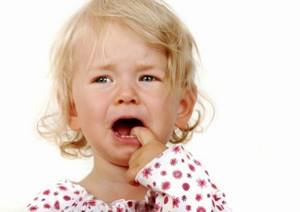
What kind of teeth come in at 2 years old?
How to recognize that your baby is teething
In order for the parent to react in time and help the baby, he must understand that the moment has come when the child begins to have teeth. And parents should not confuse the signs of teething with anything.
How to understand that teeth have begun to cut:
- swelling and inflammation of the gums, as if they are swelling;
- there may be redness of the cheeks;
- salivation is very active, saliva sometimes ends up on the chin, cheek or neck, and irritation appears in this place;
- the child is capricious, restless, hardly sleeps during the day and wakes up at night;
- to reduce itching in the gum, the baby rubs it with his fist, tries to chew and suck something;
- the child's appetite is reduced;
- the temperature rises (the threshold for increase varies from person to person).

The child is capricious and may refuse to eat
Moreover, if the gums are swollen, this does not mean that the tooth will erupt literally today. Redness of the gums and swelling may appear two weeks before the tooth erupts. This is why this period is so difficult for many children: the child simply gets tired of constant discomfort and pain.
It can be especially difficult for a baby's chewing, wider teeth to erupt. The area of eruption is different, so this period can be difficult.
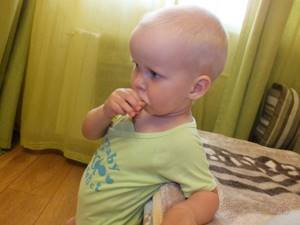
Chewing teeth are especially difficult to cut
By the way, not all symptoms, popularly called signs of teething, are actually associated with tooth growth. For example, some parents consider diarrhea, nausea, cough and runny nose to be a possible reaction to teething. But most pediatricians will not agree with this opinion. They say that the connection between these symptoms and teething can be motivated only by the fact that while the teeth are “coming”, the body is under tension, the immune system is slightly weakened. Against this background, as you might guess, you can catch the virus faster.
Signs of teething
Common signs of teething include those that affect the entire body. However, they can indicate both the imminent appearance of teeth and a disease - a cold, poisoning, intestinal infection, a feeding disorder or a change in conditions. These are symptoms such as:
- temperature increase;
- malaise, weakness;
- poor appetite;
- anxiety, sleep disturbance;
- cough, runny nose.
If these symptoms appear and do not disappear for a long time, and the child’s gums and behavior do not indicate approaching teeth, you should call a doctor at home as soon as possible.
Scheme of baby teeth eruption
To make it easier for parents to navigate the teething system, they can print out a reminder for themselves with a picture of the jaws, an indication of the teeth, and a description of exactly when certain dental units are cut.
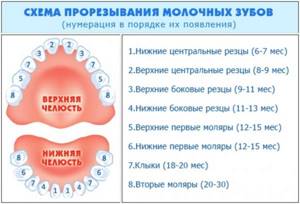
Scheme of baby teeth eruption
This is how a child’s teeth erupt according to the following pattern:
- 6-10 months – central incisor, lower jaw;
- 8-12 months – central incisor, upper jaw;
- 9-13 months – lateral incisors, upper jaw;
- 10-16 months – lateral incisors, lower jaw;
- 13-19 months – molar, upper jaw;
- 14-18 months – molar, lower jaw;
- 16-22 months – canines, upper jaw;
- 17-23 months – canines, lower jaw;
- 23-31 months – second molar, lower jaw;
- 21-31 months – second molar, upper jaw.
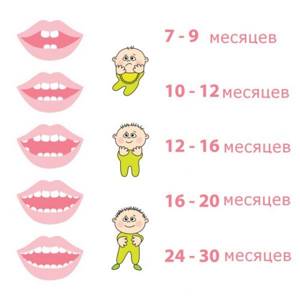
Timing and sequence of teething
It turns out that at the age of two, the second molars of both jaws usually emerge. But it is difficult to say whether this is the most difficult teething for the baby. It is believed that fangs are more painful, which is due to their sharp edges. They literally tear the gums apart. The canines of the upper jaw are perhaps the most painful in their eruption. They are also called ophthalmic because they are connected to the facial nerve.
Table. Features of the eruption of baby teeth
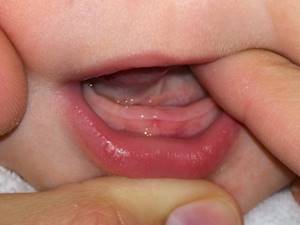
Many parents think that the first teeth are the most painful to cut, and the eruption of molars in two-year-old children is not accompanied by such pain. Therefore, parents may not understand what causes the capricious behavior of a two-year-old child, or what worries him.
Teething schedule
It is believed that the earliest milk teeth begin to erupt when a child is six months old . Depending on the individual characteristics of the body and heredity, they may appear a couple of months earlier or later.
As a rule, if a child’s first teeth erupt with a slight deviation in timing, then the time of appearance of the rest will change accordingly .
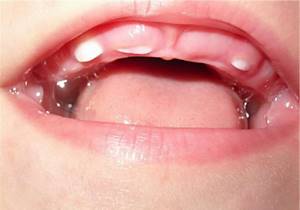
Baby teeth erupt in strict sequence
Teeth, however, always appear in a strictly prescribed order . A slight change in timing is not a pathology, but missing your turn for teething is already a reason to contact a pediatric dentist.
If we take average statistics, the timing of the appearance of primary incisors, canines and molars is approximately as follows:
- The first to appear at the age of six months are the central incisors from below ;
- after another two months, the central incisors appear on the upper jaw ;
- when the child turns 10 months old, two upper lateral incisors ;
- a year after birth, the lower lateral incisors and the child’s mouth should therefore contain 8 erupted teeth;
- first molars, both upper and lower , begin to erupt at the age of 14-16 months;
- the upper canines (16-18 months) and lower canines (18-20 months) appear
- at the age of 20-24 you can, perhaps, wait for the last ones - the second molars above and below .
So how many teeth does a 2 year old child have? As a rule, by the age of 2, a child already has 16 or more baby teeth that have fully erupted, and their replacement with molars will begin at about 6 years of age.
In principle, there is a formula for calculating the normal number of teeth at a given age in a child. According to it, the number of teeth is equal to the number of months lived minus four . That is, at two years (24 months) a child in most cases should have from 16 to 20 erupted samples.
However, the quantity may differ from the statistically averaged indicators. In most cases, being 1-2 copies late is not a cause for concern and will be made up in the coming months of life.
However, if the lag in quantity is serious, or they have not appeared at all after 7 months, this may be a sign of a disease , for example, rickets.
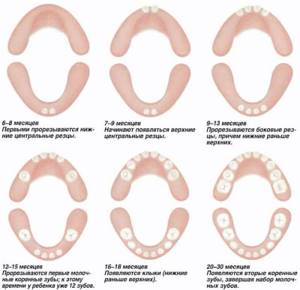
Baby teeth eruption schedule
How second molars are cut in two-year-old children
Chewing teeth are located further than the incisors and canines; it is correct to call them premolars and molars. The popular name for these dental units is molars or back teeth. It cannot be said that chewing teeth erupt without problems. For some children, the eruption of molars is at least uncomfortable.
Read also: Sequence of baby teething
When the second molars erupt, the following symptoms may be observed:
- sleep problems. It is difficult for the child to fall asleep during the day, he often wakes up at night;
- a general expression of anxiety. The baby is irritable, capricious, whiny;

The child is usually irritable and whiny
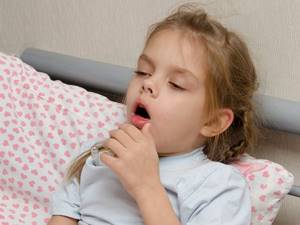
The child may cough
In rare cases, the baby may even develop allergies or diathesis. In any case, all the signs indicate that the baby is going through a difficult period - he is in pain, uncomfortable, scared. He suffers, but is not always able to convey to his parents the reason for his concern. It is imperative to help the child ease this difficult period.
What should parents do when their children are teething?
If you notice the first symptoms of teething, the tactics of behavior during this period should be as follows. The child’s daily routine is as calm and familiar as possible. No long journeys, visits or other unusual events. The child should sleep at home, in his favorite crib under his favorite blanket. At this time, it is especially important for him to feel the stability that familiar circumstances and surroundings give him.

Ensure a calm daily routine
If a child clings to his mother all the time, the mother should be nearby as much as possible. Do not show your irritation, do not raise your voice, calm down and smile. It is important to try to distract the baby, but only gently, without pressure: read a book to him, draw with him, play with a construction set.
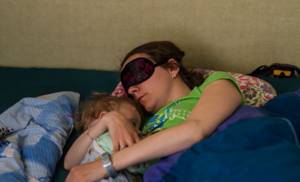
Don't leave your child alone
It is very important not to force your child to eat. He already has serious discomfort in his mouth, the eruption site itches. Doctors believe that not every adult would endure this period. Therefore, these days you can make some concessions on the menu. Prepare something that your child is always willing to eat. Food should not be solid; hot and cold foods are also excluded.
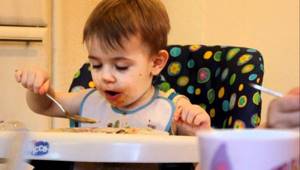
The child should eat himself, according to his appetite
But it’s better to give up sweets completely at this time. The body is under stress, it reacts to teething as it usually responds to an inflammatory process. And eating sweets during this period can be equated to adding fuel to the fire. This will definitely not support a weakened body.

It is better to replace sweets with berries or fruits
Special gels will help to facilitate the teething process. For example, the same Kalgel based on lidocaine. It is a mild anesthetic that relieves inflammation and redness. If a child may have an allergic reaction to the components of the medicine, this medicine must be discarded. Younger children love so-called silicone teethers, which help them relieve itchy gums. But even two-year-olds often enjoy using such a device.
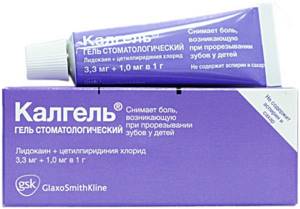
Gum massage is another option for helping a child during such a difficult period. You just need to do it with perfectly clean hands, gentle and delicate movements. If the child does not like such manipulations, stop the massage. But usually children respond well to it. You can do a massage before bed by turning on your child’s favorite lullaby. Pleasant associations make this procedure comfortable for the baby.
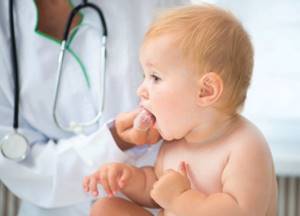
If your child has a fever
A temperature of 37 degrees is considered normal; up to 37.5 this will also not be considered a special or complicated situation. Children usually feel fine with such a slight increase in temperature. Naturally, there is no point in giving an antipyretic in this case.
If the temperature rises above 38 degrees, it is worth saying that inflammation or infection has joined the teething process. This situation requires seeing a doctor (he needs to be called to your home), and only his recommendations will be your tactics in future behavior.

Call your pediatrician if you have a fever
During teething the temperature is usually:
- rises in the evening, at night;
- lasts up to three days;
- requires an antipyretic if the child is suffering.
There is no exact temperature mark when you need to go for medicine. Of course, a temperature above 39 is already a serious signal; in this case, medical supervision is required. But some parents strive to bring down the temperature at 37.5, while others believe the figure is 38.5 -39 degrees.
Temperatures above 39 degrees are dangerous because the child may experience seizures. The baby’s brain is still adapted to such changes in body temperature, and such a neurological reaction is natural. But this condition is not harmless - be sure to call a doctor. It is also dangerous that fever causes dehydration and exhaustion of the small body. The younger the child, the more dangerous this situation is: fever in children, especially persistent fever, requires hospitalization.
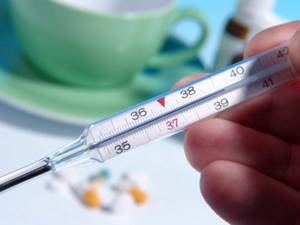
If the temperature is very high, seizures may occur
And remember that the antipyretic should be strictly for children, ideally recommended by a doctor. These are usually paracetamol-based drugs. If they do not help, you can give the child Ibuprofen (but it is prescribed to children from one year old).
But under no circumstances should children be given medications of the aspirin and analgin group. These are toxic drugs that cause side effects.
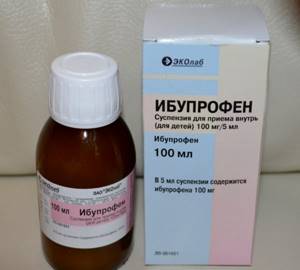
An excellent tactic for high temperatures would be to humidify the air in the room, regularly ventilate (while the child is in another room), drink plenty of fluids and eat as desired. The child should drink a lot of warm drinks and eat only when he wants to. Avoid dry air, wrapping yourself up in three pajamas and two blankets. If a child wants to play at a high temperature, there is no need to force him to go to bed.
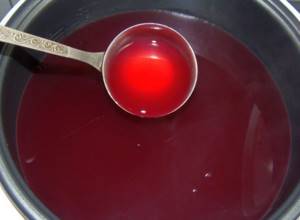
Give your child warm drinks
It is important to understand that if the temperature is elevated for more than three days, it is unlikely that the problem is teething. And when it still doesn’t go astray, urgently call a doctor and look for the real reason for this reaction of the body.
Teething is not a very long period. By the age of three, it is definitely completed, and then you will already wait for the loss of milk teeth and the growth of permanent ones. As a rule, the child tolerates these processes normally. To make sure everything is in order, visit your pediatric dentist every six months. You can take care of baby teeth from the moment they appear. Teach your child to brush his teeth twice a day, monitor the quality of brushing.
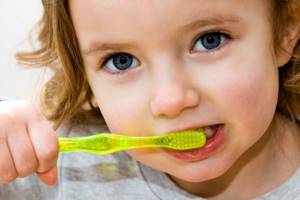
Teach your child to brush his baby teeth
Teething in children
With the appearance of the first teeth, you should take care of their health so that you do not have to treat your child at the dentist later.
In order for the parent to react in time and help the baby, he must understand that the moment has come when the child begins to have teeth. And parents should not confuse the signs of teething with anything.
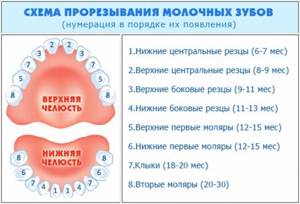
How to understand that teeth have begun to cut:
- swelling and inflammation of the gums, as if they are swelling;
- there may be redness of the cheeks;
- salivation is very active, saliva sometimes ends up on the chin, cheek or neck, and irritation appears in this place;
- the child is capricious, restless, hardly sleeps during the day and wakes up at night;
- to reduce itching in the gum, the baby rubs it with his fist, tries to chew and suck something;
- the child's appetite is reduced;
- the temperature rises (the threshold for increase varies from person to person).
Moreover, if the gums are swollen, this does not mean that the tooth will erupt literally today. Redness of the gums and swelling may appear two weeks before the tooth erupts. This is why this period is so difficult for many children: the child simply gets tired of constant discomfort and pain.
It can be especially difficult for a baby's chewing, wider teeth to erupt. The area of eruption is different, so this period can be difficult.
By the way, not all symptoms, popularly called signs of teething, are actually associated with tooth growth. For example, some parents consider diarrhea, nausea, cough and runny nose to be a possible reaction to teething.
But most pediatricians will not agree with this opinion. They say that the connection between these symptoms and teething can be motivated only by the fact that while the teeth are “coming”, the body is under tension, the immune system is slightly weakened.
Against this background, as you might guess, you can catch the virus faster.
Chewing teeth are located further than the incisors and canines; it is correct to call them premolars and molars. The popular name for these dental units is molars or back teeth. It cannot be said that chewing teeth erupt without problems. For some children, the eruption of molars is at least uncomfortable.
A temperature of 37 degrees is considered normal; up to 37.5 this will also not be considered a special or complicated situation. Children usually feel fine with such a slight increase in temperature. Naturally, there is no point in giving an antipyretic in this case.
If the temperature rises above 38 degrees, it is worth saying that inflammation or infection has joined the teething process. This situation requires seeing a doctor (he needs to be called to your home), and only his recommendations will be your tactics in future behavior.
During teething the temperature is usually:
- rises in the evening, at night;
- lasts up to three days;
- requires an antipyretic if the child is suffering.
There is no exact temperature mark when you need to go for medicine. Of course, a temperature above 39 is already a serious signal; in this case, medical supervision is required. But some parents strive to bring down the temperature at 37.5, while others believe the figure is 38.5 -39 degrees.
Temperatures above 39 degrees are dangerous because the child may experience seizures. The baby’s brain is still adapted to such changes in body temperature, and such a neurological reaction is natural.
But this condition is not harmless - be sure to call a doctor. It is also dangerous that fever causes dehydration and exhaustion of the small body.
The younger the child, the more dangerous this situation is: fever in children, especially persistent fever, requires hospitalization.
And remember that the antipyretic should be strictly for children, ideally recommended by a doctor. These are usually paracetamol-based drugs. If they do not help, you can give the child Ibuprofen (but it is prescribed to children from one year old).
But under no circumstances should children be given medications of the aspirin and analgin group. These are toxic drugs that cause side effects.
An excellent tactic for high temperatures would be to humidify the air in the room, regularly ventilate (while the child is in another room), drink plenty of fluids and eat as desired. The child should drink a lot of warm drinks and eat only when he wants to. Avoid dry air, wrapping yourself up in three pajamas and two blankets. If a child wants to play at a high temperature, there is no need to force him to go to bed.
It is important to understand that if the temperature is elevated for more than three days, it is unlikely that the problem is teething. And when it still doesn’t go astray, urgently call a doctor and look for the real reason for this reaction of the body.
Teething is not a very long period. By the age of three, it is definitely completed, and then you will already wait for the loss of milk teeth and the growth of permanent ones. As a rule, the child tolerates these processes normally. To make sure everything is in order, visit your pediatric dentist every six months. You can take care of baby teeth from the moment they appear. Teach your child to brush his teeth twice a day, monitor the quality of brushing.
https://youtu.be/AS-nzl5uCzc
expertdent.net
The baby’s jaw fills gradually, and this is a purely individual process. In modern medicine, there is a certain pattern of teeth eruption, which indicates when and which tooth begins to emerge.
At first these are the central incisors of the lower row for 6-7 months, but the upper positions do not linger either, they appear by 7-8 months. Next, the lateral canines and molars grow, and the mother only observes the development of the baby and the replenishment of the dentition.
Root positions appear last when the baby is already 2 years old.
Ideally, at this age there will be 16 units. There are known cases from pediatric practice when there were 20 of them, but variants of a smaller number are also possible. How many baby teeth a child has at 2 years old depends on his living conditions and the individual characteristics of the tiny organism. If the real indicator differs radically from generally accepted rules, doctors suspect a health problem.
WHO standards for children
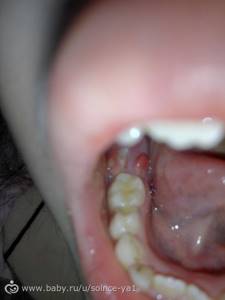
How to determine that a child is already cutting his first tooth? Symptoms of a baby's first teeth erupting include red, inflamed gums, burning cheeks and, possibly, an already swollen white ball from which a tooth is about to emerge. True, he can make himself wait. Before being exposed, the tooth must first pass through the bone tissue that surrounds it, and then through the mucous membrane of the gums.
Is it necessary to somehow help teething? You should not interfere with the natural course of events, because nature has provided that children’s teeth are born independently, without special external efforts or additional devices.
There is no need to irritate your baby's gums by scratching them with a piece of sugar or the handle of a spoon, as was done before. This can damage delicate baby teeth and cause infection in the jaw bone.
Be careful with bagels, bread crusts, bagels: their crumbs can get stuck in the respiratory tract.
During a person’s life, 20 teeth change once, and the remaining 12 teeth do not change; they erupt initially as permanent teeth (molars).
Teething. First (medial) lower incisors - 6-9 months. First (medial) upper incisors - 7-10 months. Second (lateral) upper incisors - 9-12 months. Second (lateral) lower incisors - 9-12 months. .First upper molars - 12-18 months. First lower molars - 13-19 months. Upper canines - 16-20 months. Lower canines - 17-22 months. Second lower molars - 20-33 months. Second upper molars teeth - 24-36 months.
These tables are approximate. According to statistics, the first tooth in modern infants appears on average only at 8 and a half months.
Thus, the timing of the eruption of other teeth is shifted. Dentists believe that the later the first tooth erupts, the later the baby teeth will begin to fall out and this is undoubtedly good.
However, before the baby is one year old, at least one tooth must appear, otherwise the causes should be looked for in some diseases, for example, rickets. The first tooth can be paired with the second, and the same is true with subsequent teeth.
It happens that a baby has 4 teeth at once. Naturally, such “massive” growth of teeth affects the timing of teething.
The situation is also uncertain with the order in which teeth appear; you simply cannot influence this, so “don’t worry in vain,” because everything goes as nature intended.
By the age of three, all baby teeth erupt in a child, which by the age of 5 begin to gradually be replaced by permanent ones.
There are 20 primary teeth in total: on each jaw there are 4 incisors (4 central teeth), 2 canines (third teeth) and 4 molars (fourth and fifth teeth).
By the age of 10-12 years there are 28 teeth.
An adult normally has 28-32 permanent teeth: each jaw has 4 incisors, 2 canines, 4 premolars and 4-6 molars. The development of the third molar (“wisdom tooth”) may not occur at all, with congenital edentia of the third molars, which is also considered normal.
Another situation is also possible: a wisdom tooth is embedded in the thickness of the jaw, but does not erupt due to incorrect position or lack of space in the jaw. This situation occurs very often.
After all the baby teeth have erupted, there are no gaps (gaps, gaps) between them, which is normal. But as the jaw grows, before the baby teeth are replaced by permanent ones, gaps should appear between the baby teeth. This process is necessary because permanent teeth are larger in size than baby teeth and if spaces are not formed, then the permanent teeth do not fit in the jaws and the child receives “crooked” permanent teeth.
In parallel with the formation of spaces between temporary teeth, the roots of baby teeth are “reabsorbed”, after which the teeth alternately become loose and fall out. Nowadays there is even a fashion to buy a box made of gold or silver to store the first teeth.
There is no general opinion about the normal timing of teething, since scientific studies by different authors were carried out in different regions and in different years of the last and present century.
Teething may be accompanied by increased excitability: the child becomes restless, capricious, often wakes up crying at night, and may refuse to eat. At the same time, the baby puts any object in his mouth, since chewing reduces the itching of irritated gums.
The secretion of saliva is sharply increased, which, flowing from the mouth, can cause skin irritation. Often, a limited area of redness or rash appears on the cheek on the side of the erupting tooth.
The child's temperature may rise to subfebrile levels (within 37.8°). However, fever does not necessarily accompany teething.
What remedies relieve pain? The simplest thing is cold. Cold relieves pain and reduces swelling. If this does not help, you can use dental gel or ointment containing anti-inflammatory and pain relievers to lubricate the gums. If necessary, you can give your child a pain reliever. Any medications should be used only as prescribed by a doctor.
During teething, one or another infection may develop. Therefore, if your baby develops symptoms such as nausea, vomiting, ear pain, diarrhea, cough, rash, persistent loss of appetite or high fever, you should consult a doctor.
Expansion of spaces between teeth. It may reflect increased jaw growth and during the transition period from baby teeth to permanent teeth is regarded as a normal condition. A wide gap between the front incisors on the upper jaw is usually associated with a deep-lying maxillary frenulum. The tactics for monitoring and treating wide gaps between teeth are determined by an orthodontist.
A blackish edging on the neck of the tooth can be due to the use of soluble iron preparations or a chronic inflammatory process (precipitation of bacteria of the leptotrichium group);
Yellowish-brown staining of teeth is most often associated with the use of antibiotics by the mother in the second half of pregnancy or by the child during the period of teeth formation.
A yellowish-greenish color develops in severe disorders of bilirubin metabolism and hemolytic (destruction of red blood cells) conditions;
Reddish staining of tooth enamel is characteristic of a congenital disorder of pigment metabolism - porphyrin. This disease is called porphyria;
Timely growth of teeth in a certain sequence indicates the normal development of the baby’s body. This is a physiological process and is directly related to the general health of the child. But let’s consider some atypical situations that may indirectly indicate the presence of pathology. However, only indirectly. Let us make a reservation once again that only careful research can confirm or refute these assumptions.
Let us turn to the recommendations of the World Health Organization (WHO) to once and for all understand the most frequently asked questions to a dentist, namely:
- permissible deviations in the timing of teething in a situation of normal development of the baby;
- possible shifts in the designated periods, indicating pathological processes in the child’s body;
- how and what techniques are used for dental treatment for children 2 years old.
Permissible deviations
If we refer to official statistics demonstrating the answer to the question - how many teeth should a child have at two years old, then by the age of 2-2.5 years the baby may well become the proud owner of a full set of milk teeth in the amount of 20 pieces.
Let us immediately note that they are located in pairs on opposite sides on the upper and lower jaws, respectively:
- central incisors;
- lateral incisors;
- fangs;
- first molars;
- second molars.
The most common method of treating caries in children is silvering. Its essence is to apply silver ions to the tooth enamel. Silver effectively kills bacteria, but, nevertheless, this method is acceptable only at the initial stage of caries. Another disadvantage is the darkening of the tooth after treatment. Not all parents agree to such an aesthetic defect in their baby.
An alternative option is a drill. In case of advanced caries, this is the only effective method. Mechanical removal of carious tissue inside a tooth is a rather painful process. It is impossible to do without local, and in most cases, general anesthesia. Of course, this is not a common practice and is used in extreme cases.
Among the innovative methods, there are methods such as:
- laser processing;
- manual cleaning of the tooth cavity with a special tool;
- treatment with special reagents.
According to the dentists themselves, the optimal, most effective method of treatment is still the use of a drill.
If we take the average statistical data, teething in children begins at 6 months. But it often happens that in a family with two or more children, the timing of the appearance of teeth can range from 5 months to a year. In this regard, the child becomes restless: he eats poorly, sleeps, and constantly cries.
The period of teething is not always simple and joyful. Parents have to put in a lot of effort and patience during this difficult period for the baby.
The child is constantly bothered by itching, pain and other negative aspects. To completely alleviate the baby’s suffering, they have not yet come up with such a method.
Both adults and children are all individual. And it is necessary to find an approach to each individual individually.
To understand which method is most effective for your child, you need to try different methods and observe the reaction.
Many parents are put off by the accepted timing of teething. Babies are individual - some teeth erupt at 6 months, some earlier, some later. If teeth appear on time, this indicates the full development of the baby; an important factor is the pairing of their appearance.
Usually the lower incisor is the first to appear; it can appear alone or in pairs. This occurs between 6 and 8 months of age.
Further according to the plan, at 7-10 months the upper central incisors appear. There is a certain pattern of appearance: top-bottom and so on. But again, everything is individual. By 9-12 months, children have upper and lower lateral incisors. A child should already have at least 8 teeth per year.
After one year, children begin to have chewing teeth. These include molars. There should be 4 of them. Fangs appear later, at the age of 16-20 months. A 3 year old child should have about 20 teeth. But it could be less.
Pediatricians created a formula to calculate the number of teeth. With the help of which parents can independently control the appearance of teeth. Just for fun, use some simple calculations.
To do this, you need to take the child’s age in months and subtract the number 4. The result will correspond to the proper number of teeth the baby has. The formula is designed for children up to 2 years old. As with any mathematical formula, errors are allowed. Each child has its own norm. If you have any concerns, it is better to consult a doctor.
The main symptoms of teething in children, as a rule, do not go unnoticed by sensitive parents:
- The child becomes very irritated.
- May refuse to eat (even breast milk).
- Sleep and normal daily routine are disrupted.
- An evening bath, instead of calming you down, brings a new batch of tears.
During this period, it is very important to be able to distinguish the first signs of teething from the beginning of pathological processes in a small organism. Thus, cutting teeth easily give a picture of a viral disease, because at the beginning of the process there is not only constantly flowing saliva, but also sniffles and an elevated temperature.
If your baby is teething, it is important to make sure that only this moment is the cause of changes in behavior. Pay attention to:
- baby’s stool (is it regular, are there any changes);
- lymph nodes (are they enlarged);
- body temperature (dental problems can cause sudden increases, but more often such suppositories are provoked by a virus).
Temperature
The manifestation of this unpleasant symptom depends entirely on the characteristics of the individual organism and the state of its immune system. Older children react less actively to the process of the appearance of new bone formations, so fever is less common than in infants.
Babies are not so lucky in this regard: the first incisors give them a lot of unpleasant sensations, and there is a persistent increase in body temperature above 38 degrees. Temperature during teething as a reaction of the body is explained by local irritation of the gums and weak immune defense.
Runny nose and cough
How to determine that a child is already cutting his first tooth? Symptoms of a baby's first teeth erupting include red, inflamed gums, burning cheeks and, possibly, an already swollen white ball from which a tooth is about to emerge.
True, he can make himself wait. Before being exposed, the tooth must first pass through the bone tissue that surrounds it, and then through the mucous membrane of the gums.
Is it necessary to somehow help teething? You should not interfere with the natural course of events, because nature has provided that children’s teeth are born independently, without special external efforts or additional devices.
There is no need to irritate your baby's gums by scratching them with a piece of sugar or the handle of a spoon, as was done before. This can damage delicate baby teeth and cause infection in the jaw bone.
Be careful with bagels, bread crusts, bagels: their crumbs can get stuck in the respiratory tract.
During a person’s life, 20 teeth change once, and the remaining 8-12 teeth do not change; they erupt initially as permanent teeth (molars).
These tables are approximate. According to statistics, the first tooth in modern infants appears on average only at 8 and a half months.
Thus, the timing of the eruption of other teeth is shifted. Dentists believe that the later the first tooth erupts, the later the baby teeth will begin to fall out and this is undoubtedly good.
However, before the baby is one year old, at least one tooth must appear, otherwise the causes should be looked for in some diseases, for example, rickets. The first tooth can come in pairs, and the same is true with subsequent teeth.
It happens that a baby has 4 teeth at once. Naturally, such “massive” growth of teeth affects the timing of teething.
The situation is also uncertain with the order in which teeth appear; you simply cannot influence this, so “don’t worry in vain,” because everything goes as nature intended.
The earliest signs indicating the imminent eruption of the incisors usually appear at the age of 4–5 months. The first teeth come out with slight discomfort. Sometimes children develop symptoms that resemble a cold. The most difficult period for parents and children is the age of up to one year, when the baby reacts very sharply to pain.
The main symptoms include:
- increased salivation,
- cough if saliva gets into the throat;
- breast refusal;
- slight swelling and redness of the gums;
- runny or stuffy nose;
- the child puts his fingers and fists into his mouth;
- worsening sleep;
- slight increase in temperature.
Later, when the teeth approach the surface of the gums, whitish tubercles appear on it, and if you lightly tap them with a teaspoon, you can feel them. Sometimes during the teething period, rashes may appear on the cheeks and chin of children as a manifestation of the body’s reaction.
In principle, the symptoms of teething in children of any age are the same, only the reaction to discomfort is different. Another thing is the change of baby teeth and the appearance of permanent teeth.
Both the loss of baby teeth and the eruption of molars should occur on a schedule and be monitored by a good pediatric dentist. It will help facilitate the process and form the correct bite.
The appearance of molars in a child occurs at the age of five to six years. At this time, resorption of the roots of baby teeth and an increase in the interdental space are observed.
Gradually, molars replace baby teeth, and it is very important to monitor the formation of the bite during this period.
If the timing of teething in infants is not so important, then molars should appear within the physiological periods:
- The appearance of molars occurs between the ages of 6 and 7 years.
- Eruption of central incisors - up to 8 years.
- Lateral incisors - up to 9 years.
- The appearance of premolars occurs at 10–12 years.
- Fangs erupt before age 12.
- By the age of 13, the second molars appear.
- Wisdom teeth - up to 25 years.
Typically, the lower teeth erupt before the upper teeth.
If the eruption of molars occurs much earlier than expected, it is worth informing the pediatrician and seeking advice from a pediatric endocrinologist. Late eruption indicates an imbalance in hormones and is also a reason to consult a doctor.
Teething. First (medial) lower incisors - 6-9 months. First (medial) upper incisors - 7-10 months. Second (lateral) upper incisors - 9-12 months. Second (lateral) lower incisors - 9-12 months. .First upper molars - 12-18 months. First lower molars - 13-19 months. Upper canines - 16-20 months. Lower canines - 17-22 months. Second lower molars - 20-33 months. Second upper molars teeth - 24-36 months.
Pediatricians call it normal for a two-year-old child to have 20 baby teeth, which are located 10 on each jaw of the baby. However, in some children, the last four teeth (second molars) may not yet emerge.
And therefore, the presence of 16 teeth at 2 years of age is also normal. These teeth often erupt between 20-26 months in the lower jaw and 26-33 months in the upper jaw.
This is why some two-year-olds may not have them.
